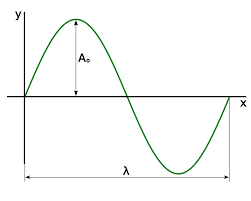9th Grade > Physics
SOUND MCQs
Total Questions : 57
| Page 6 of 6 pages
Answer: Option B. ->
False
:
B
The particles in a wave only oscillate about their position. They do not move at the speed of the wave, nor do they need to move in the same direction as that of the wave.
:
B
The particles in a wave only oscillate about their position. They do not move at the speed of the wave, nor do they need to move in the same direction as that of the wave.
Answer: Option A. ->
electric signals
:
A
:
A
The cochlea of the ear converts pressure variations in the air (sound) into electric signals. These signals travel to the brain through auditory nerves, due to which we are able to hear it.
Answer: Option A. ->
5 s
:
A
Given:
Wavelength of sound wave, λ=40 cm=0.4 m
Time period, T=0.0005 s
Distance travelled, s=4 km=4000 m
Let speed of sound wave be v.
Speed of a wave is the product will be:
v=λT
v=0.4 m0.0005 s
v=800 ms−1
Let the time taken for the wave to travel distance s be t.
From definition of speed,
v=st
t=sv
t=4000800=5 s
:
A
Given:
Wavelength of sound wave, λ=40 cm=0.4 m
Time period, T=0.0005 s
Distance travelled, s=4 km=4000 m
Let speed of sound wave be v.
Speed of a wave is the product will be:
v=λT
v=0.4 m0.0005 s
v=800 ms−1
Let the time taken for the wave to travel distance s be t.
From definition of speed,
v=st
t=sv
t=4000800=5 s
Answer: Option C. ->
1470
:
C
Given:
Distance between source and observer, s=1000 m
Velocity of sound, v=340 ms−1
Frequency of sound, f=500 Hz
Time taken for the sound wave to reach the observer from the source is:
t=sv
Number of oscillations in 1 s is the frequency, f
Number of oscillations in time t will be:
n=tf
n=svf
n=1000×500340
n≈1470
:
C
Given:
Distance between source and observer, s=1000 m
Velocity of sound, v=340 ms−1
Frequency of sound, f=500 Hz
Time taken for the sound wave to reach the observer from the source is:
t=sv
Number of oscillations in 1 s is the frequency, f
Number of oscillations in time t will be:
n=tf
n=svf
n=1000×500340
n≈1470
Answer: Option A. ->
Echocardiography
:
A and B
A sound which has a frequency of 20,000 Hz or more, is called ultrasonic sound, or simply, ultrasound.
Ultrasonic sound waves are made to reflect from various parts of the heart, and form an image of the heart. This technique is called echocardiography.
Images of body organs are generated by sending ultrasonic sound through the tissues of human body. This is called ultrasonography.
MRI uses magnetic fields and radio waves to capture images of the organs.
Loudspeakers are devices that increases the amplitude of sound waves with the help of electrical energy.
:
A and B
A sound which has a frequency of 20,000 Hz or more, is called ultrasonic sound, or simply, ultrasound.
Ultrasonic sound waves are made to reflect from various parts of the heart, and form an image of the heart. This technique is called echocardiography.
Images of body organs are generated by sending ultrasonic sound through the tissues of human body. This is called ultrasonography.
MRI uses magnetic fields and radio waves to capture images of the organs.
Loudspeakers are devices that increases the amplitude of sound waves with the help of electrical energy.
Answer: Option A. ->
SONAR
:
A
The device which uses ultrasonic waves to measure the distance, direction and speed of underwater objects is known as SONAR. SONAR stands for Sound Navigation and Ranging.
It is used to find depth of the sea and to locate underwater hills, valleys, icebergs, sunken ships etc.
RADAR uses electromagnetic waves for echolocation. Also, it must be noted that RADAR is not useful underwater because electromagnetic waves die in water very quickly.
:
A
The device which uses ultrasonic waves to measure the distance, direction and speed of underwater objects is known as SONAR. SONAR stands for Sound Navigation and Ranging.
It is used to find depth of the sea and to locate underwater hills, valleys, icebergs, sunken ships etc.
RADAR uses electromagnetic waves for echolocation. Also, it must be noted that RADAR is not useful underwater because electromagnetic waves die in water very quickly.

















